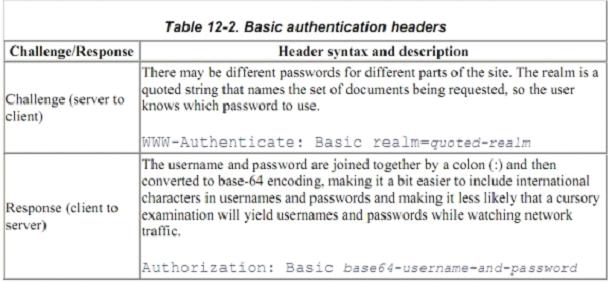HTTP's Challenge/Response Authentication Framework
HTTP provides a native challenge/response framework to make it easy to authenticate users. HTTP's authentication model is sketched in Figure 12-1.

Whenever a web application receives an HTTP request message, instead of acting on the request, the server can respond with an "authentication challenge," challenging the user to demonstrate who she is by providing some secret information.
The user needs to attach the secret credentials (username and password) when she repeats the request. If the credentials don't match, the server can challenge the client again or generate an error. If the credentials do match, the request completes normally.
Basic authentication

When a server challenges a user, it returns a 401 Unauthorized response and describes how and where to authenticate in the WWW-Authenticate header (Figure 12-2b).
When a client authorizes the server to proceed, it resends the request but attaches an encoded password and other authentication parameters in an Authorization header (Figure 12-2c).
When an authorized request is completed successfully, the server returns a normal status code (e.g., 200 OK) and, for advanced authentication algorithms, might attach additional information in an Authentication-Info header (Figure 12-2d).
Before we discuss the details of basic authentication, we need to explain how HTTP allows servers to associate different access rights to different resources. You might have noticed that the WWW-Authenticate challenge in Figure 12-2b included a realm directive. Web servers group protected documents into security realms. Each security realm can have different sets of authorized users.
For example, suppose a web server has two security realms established: one for corporate financial information and another for personal family documents (see Figure 12-3). Different users will have different access to the realms. The CEO of your company probably should have access to the salesforecast, but you might not give her access to your family vacation photos!
In basic authentication, a web server can refuse a transaction, challenging the client for a valid username and password. The server initiates the authentication challenge by returning a 401 status code instead of 200 and specifies the security realm being accessed with the WWW-Authenticate response header. When the browser receives the challenge, it opens a dialog box requesting the username and password for this realm. The username and password are sent back to the server in a slightly scrambled format inside an Authorization request header.
























 611
611

 被折叠的 条评论
为什么被折叠?
被折叠的 条评论
为什么被折叠?








